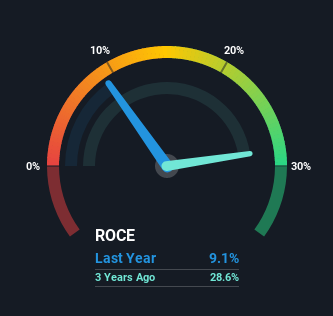Sarveshwar Foods (NSE:SARVESHWAR) Is Reinvesting At Lower Rates Of Return

There are a few key trends to look for if we want to identify the next multi-bagger. Typically, we'll want to notice a trend of growing return on capital employed (ROCE) and alongside that, an expanding base of capital employed. Basically this means that a company has profitable initiatives that it can continue to reinvest in, which is a trait of a compounding machine. However, after investigating Sarveshwar Foods (NSE:SARVESHWAR), we don't think it's current trends fit the mold of a multi-bagger.
What is Return On Capital Employed (ROCE)?
If you haven't worked with ROCE before, it measures the 'return' (pre-tax profit) a company generates from capital employed in its business. Analysts use this formula to calculate it for Sarveshwar Foods:
Return on Capital Employed = Earnings Before Interest and Tax (EBIT) ÷ (Total Assets - Current Liabilities)
0.091 = ₹183m ÷ (₹5.1b - ₹3.1b) (Based on the trailing twelve months to March 2021).
Therefore, Sarveshwar Foods has an ROCE of 9.1%. Ultimately, that's a low return and it under-performs the Food industry average of 12%.
View our latest analysis for Sarveshwar Foods

Historical performance is a great place to start when researching a stock so above you can see the gauge for Sarveshwar Foods' ROCE against it's prior returns. If you're interested in investigating Sarveshwar Foods' past further, check out this free graph of past earnings, revenue and cash flow.
What The Trend Of ROCE Can Tell Us
On the surface, the trend of ROCE at Sarveshwar Foods doesn't inspire confidence. To be more specific, ROCE has fallen from 41% over the last five years. However it looks like Sarveshwar Foods might be reinvesting for long term growth because while capital employed has increased, the company's sales haven't changed much in the last 12 months. It may take some time before the company starts to see any change in earnings from these investments.
On a related note, Sarveshwar Foods has decreased its current liabilities to 60% of total assets. That could partly explain why the ROCE has dropped. What's more, this can reduce some aspects of risk to the business because now the company's suppliers or short-term creditors are funding less of its operations. Some would claim this reduces the business' efficiency at generating ROCE since it is now funding more of the operations with its own money. Keep in mind 60% is still pretty high, so those risks are still somewhat prevalent.
Our Take On Sarveshwar Foods' ROCE
Bringing it all together, while we're somewhat encouraged by Sarveshwar Foods' reinvestment in its own business, we're aware that returns are shrinking. And investors appear hesitant that the trends will pick up because the stock has fallen 42% in the last three years. In any case, the stock doesn't have these traits of a multi-bagger discussed above, so if that's what you're looking for, we think you'd have more luck elsewhere.
If you want to know some of the risks facing Sarveshwar Foods we've found 4 warning signs (3 are significant!) that you should be aware of before investing here.
While Sarveshwar Foods isn't earning the highest return, check out this free list of companies that are earning high returns on equity with solid balance sheets.
If you’re looking to trade Sarveshwar Foods, open an account with the lowest-cost* platform trusted by professionals, Interactive Brokers. Their clients from over 200 countries and territories trade stocks, options, futures, forex, bonds and funds worldwide from a single integrated account. Promoted
New: Manage All Your Stock Portfolios in One Place
We've created the ultimate portfolio companion for stock investors, and it's free.
• Connect an unlimited number of Portfolios and see your total in one currency
• Be alerted to new Warning Signs or Risks via email or mobile
• Track the Fair Value of your stocks
This article by Simply Wall St is general in nature. We provide commentary based on historical data and analyst forecasts only using an unbiased methodology and our articles are not intended to be financial advice. It does not constitute a recommendation to buy or sell any stock, and does not take account of your objectives, or your financial situation. We aim to bring you long-term focused analysis driven by fundamental data. Note that our analysis may not factor in the latest price-sensitive company announcements or qualitative material. Simply Wall St has no position in any stocks mentioned.
*Interactive Brokers Rated Lowest Cost Broker by StockBrokers.com Annual Online Review 2020
Have feedback on this article? Concerned about the content? Get in touch with us directly. Alternatively, email editorial-team (at) simplywallst.com.
About NSEI:SARVESHWAR
Sarveshwar Foods
Manufactures and sells of basmati and non basmati rice in India.
Solid track record with adequate balance sheet.
Similar Companies
Market Insights
Community Narratives



